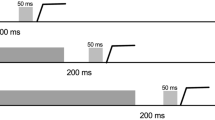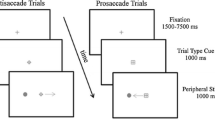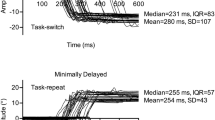Abstract
It has been hypothesized that impaired task-switching underlies some of the behavioural deficits in schizophrenia. However, task-switching involves many cognitive operations. In this study our goal was to isolate the effects on latency and accuracy that can be attributed to specific task-switch processes, by studying the inter-trial effects in blocks of randomly mixed prosaccades and antisaccades. By varying the preparatory interval between an instructional cue and the target, we assessed the costs of both (1) an active reconfiguration process that was triggered by the cue, and (2) passive carry-over effects persisting from the prior trial. We tested 15 schizophrenic subjects and 14 matched controls. A very short preparatory interval increased error rates and saccadic latencies in both groups, but more so in schizophrenia, suggesting difficulty in rapidly activating saccadic goals. However, the contrast between repeated and switched trials showed that the costs of task switching in schizophrenia were not significantly different from the controls, at either short or long preparatory intervals, for both antisaccades and prosaccades. These results confirm prior observations that passive carry-over effects are normal in schizophrenia, and show that active reconfiguration is also normal in this disorder. Thus problems with executive control in schizophrenia may not affect specific task-switching operations.



Similar content being viewed by others
References
Allport A, Styles E, Hsieh S (1994) Shifting intentional set: exploring the dynamic control of tasks. In: Umiltà C, Moscovitch M (eds) Attention and performance XV. Erlbaum, Hillsdale, pp 421–452
Bahill T, McDonald J (1983) Frequency limitations and optimal step size for the two-point central difference derivative algorithm with applications to human eye movement data. IEEE Trans Biomed Eng 30:191–194
Barton J, Cherkasova M, Lindgren K, Goff D, Manoach D (2005) What is perseverated in schizophrenia? Evidence of abnormal response plasticity in the saccadic system. J Abnorm Psychol 114:75–84
Barton J, Greenzang C, Hefter R, Edelman J, Manoach D (2006) Switching, plasticity, and prediction in a saccadic task-switch paradigm. Exp Brain Res 168:76–87
Blair J, Spreen O (1989) Predicting premorbid IQ: a revision of the national adult reading test. Clin Neuropsychol 3:129–136
Braff DL, Heaton R, Kuck J, Cullum M, Moranville J, Grant I, Zisook S (1991) The generalized pattern of neuropsychological deficits in outpatients with chronic schizophrenia with heterogeneous Wisconsin Card Sorting Test results. Arch Gen Psychiatry 48:891–898
Cherkasova M, Manoach D, Intriligator J, Barton J (2002) Antisaccades and task-shifting: interactions in controlled processing. Exp Brain Res 144:528–537
Clementz B (1998) Psychophysiological measures of (dis)inhibition as liability indicators for schizophrenia. Psychophysiology 35:648–668
Cohen J, Servan-Schreiber D (1992) Context, cortex and dopamine: a connectionist approach to behavior and biology in schizophrenia. Psychol Rev 99:45–77
Cools R, Brouwer W, deJong R, Sloof C (2000) Flexibility, inhibition and planning: frontal dysfunction in schizophrenia. Brain Cogn 43:108–112
Crider A (1997) Perseveration in schizophrenia. Schizophr Bull 23:63–74
Elliott R, McKenna P, Robbins T, Sahakian B (1995) Neuropsychological evidence for frontostriatal dysfunction in schizophrenia. Psychol Med 25:619–630
Fecteau J, Au C, Armstrong I, Munoz D (2004) Sensory biases produce alternation advantage found in sequential saccadic eye movement tasks. Exp Brain Res 159:84–91
First MB, Spitzer RL, Gibbon M, Williams JBW (1997) Structured Clinical Interview for DSM-IV Axis I Disorders, Research Version, Patient Edition with Psychotic Screen (SCID-I/P W/PSY SCREEN). Biometrics Research, New York State Psychiatric Institute, New York
Fukushima J, Morita N, Fukushima K, Chiba T, Tanaka S, Yamashita I (1990a) Voluntary control of saccadic eye movements in patients with schizophrenic and affective disorders. J Psychiat Res J Psychiat Res 24:9–24
Gold J, Carpenter C, Randolph C et al. (1997) Auditory working memory and Wisconsin Card Sorting Test performance in schizophrenia. Arch Gen Psychiatry 54:159–165
Green M, Kern R, Braff D, Mintz J (2000) Neurocognitive deficits and functional outcome in schizophrenia: are we measuring the “right stuff”? Schizophr Bull 26:119–136
Hollingshead A (1965) Two factor index of social position. Yale University Press, New Haven
Hunt A, Klein R (2002) Eliminating the costs of task set reconfiguration. Mem Cogn 30:529–539
Hutton S, Ettinger U (2006) The antisaccade task as a research tool in psychopathology: a critical review. Psychophysiology 43:302–313
Hutton S, Kennard C (1998) Oculomotor abnormalities in schizophrenia. A critical review. Neurology 50:604–609
Kalesnykas R, Hallett P (1987) The differentiation of visually guided and anticipatory saccades in gap and overlap paradigms. Exp Brain Res 68:115–121
Kieffaber P, Kappenman E, Bodkins M, Shekhar A, O’Donnell B, Hetrick W (2006) Switch and maintenance of task set in schizophrenia. Schizophr Res 84:345–358
Klein C, Heinks T, Andresen B, Berg P, Moritz S (2000) Impaired modulation of the saccadic contingent negative variation preceding antisaccades in schizophrenia. Biol Psychiatry 47:978–990
Levy D, Mendell N, LaVancher C et al (1998) Disinhibition in antisaccade performance in schizophrenia. In: Lenzenweger M, Dworkin R (eds) Origins and development of Schizophrenia. American Psychological Association, Washington, pp 185–210
Li C-SR (2004) Do schizophrenia patients make more perseverative than non-perseverative errors on the Wisconsin Card Sorting test? A meta-analytic study. Psychiatry Res 129:179–190
Los S (1996) On the origin of mixing costs: exploring information processing in pure and mixed blocks of trials. Acta Psychol 94:145–188
Manoach DS, Lindgren KA, Cherkasova MV, Goff DC, Halpern EF, Intriligator J, Barton JJS (2002) Schizophrenic subjects show deficient inhibition but intact task-switching on saccadic tasks. Biol Psychiatry 51:816–825
Manoach D, Lindgren K, Barton J (2004) Deficient saccadic inhibition in Asperger’s disorder and the social-emotional processing disorder. J Neurol Neurosurg Psychiatr 75:1719–1726
Meiran N (1996) Reconfiguration of processing mode prior to task performance. J Exp Psychol Learn Mem Cogn 22:1423–1442
Meiran N (2000) Modeling cognitive control in task switching. Psychol Res 63:234–249
Meiran N, Chorev Z, Sapir A (2000a) Component processes in task switching. Cognit Psychol 41:211–253
Meiran N, Levine J, Henik A (2000b) Task set switching in schizophrenia. Neuropsychology 14:471–482
Monsell S, Yeung N, Azuma R (2000) Reconfiguration of task-set: is it easier to switch to the weaker task? Psychol Res 63:250–264
Nieuwenhuis S, Broerse A, Nielen M, de Jong R (2004) A goal activation approach to the study of executive function: an application to antisaccade tasks. Brain Cogn 56:198–214
Perry W, Braff D (1998) A multimethod approach to assessing perseverations in schizophrenia patients. Schizophr Res 33:69–77
Reuter B, Kathmann N (2004) Using saccade tasks as a tool to analyze executive dysfunctions in schizophrenia. Acta Psychol (Amst) 115:255–269
Reuter B, Herzog E, Endrass T, Kathmann N (2006a) Brain potentials indicate poor preparation for action in schizophrenia. Psychophysiology 43:604–611
Reuter B, Herzog E, Kathmann N (2006b) Antisaccade performance of schizophrenia patients: evidence of reduced task-set activation and impaired error detection. J Psychiatr Res 40:122–130
Robert P, Lafont V, Medecin I, Berthet L, Thauby S, Baudu C, Darcourt G (1998) Clustering and switching strategies in verbal fluency tasks: comparison between schizophrenics and healthy adults. J Int Neuropsychol Soc 4:539–546
Rogers, Monsell (1995) Costs of a predictable switch between simple cognitive tasks. J Exp Psychol Gen 124:207–231
Sandson J, Albert M (1984) Varieties of perseveration. Neuropsychologia 22:715–732
Sereno A, Holzman P (1995) Antisaccades and smooth pursuit eye movements in schizophrenia. Biol Psychiatry 37:394–401
Shaffer L (1965) Choice reaction with variable S-R mapping. J Exp Psychol 70:284–288
Smith G, Large M, Kavanagh D et al (1998) Further evidence for a deficit in switching attention in schizophrenia. J Abnorm Psychol 107:390–398
Sohn M-H, Anderson J (2001) Task preparation and task repetition: two-component model of task-switching. J Exp Psychol Gen 130:764–778
Stuss D, Shallice T, Alexander M, Picton T (1995) A multidisciplinary approach to anterior attentional functions. Ann NY Acad Sci 769:191–211
Sullivan EV, Mathalon DH, Zipursky RB, Kersteen-Tucker Z, Knight RT, Pfefferbaum A (1993) Factors of the Wisconsin Card Sorting Test as measures of frontal-lobe function in schizophrenia and in chronic alcoholism. Psychiatry Res 46:175–199
Tornay FJ, Milan EG (2001) A more complete task-set reconfiguration in random than in predictable task switch. Q J Exp Psychol A 54:785–803
Turken A, Vuilleumier P, Mathalon D, Swick D, Ford J (2003) Are impairments of action monitoring and executive control true dissociative dysfunctions in patients with schizophrenia? Am J Psychiatry 160:1881–1883
Weber H (1995) Presaccadic processes in the generation of pro and anti saccades in human subjects—a reaction time study. Perception 24:1265–1280
White K, Ashton R (1976) Handedness assessment inventory. Neuropsychologia 14:261–264
Wylie G, Allport A (2000) Task switching and the measurement of “switch costs”. Psychol Res 63:212–233
Acknowledgments
JB was supported by a Canada Research Chair, a Michael Smith Foundation for Health Research Senior Scholarship, and CIHR grant MOP-81270. DSM was supported by NIMH 1R01 MH67720 and the MIND Institute.
Author information
Authors and Affiliations
Corresponding author
Rights and permissions
About this article
Cite this article
Greenzang, C., Manoach, D.S., Goff, D.C. et al. Task-switching in schizophrenia: active switching costs and passive carry-over effects in an antisaccade paradigm. Exp Brain Res 181, 493–502 (2007). https://doi.org/10.1007/s00221-007-0946-8
Received:
Accepted:
Published:
Issue Date:
DOI: https://doi.org/10.1007/s00221-007-0946-8




